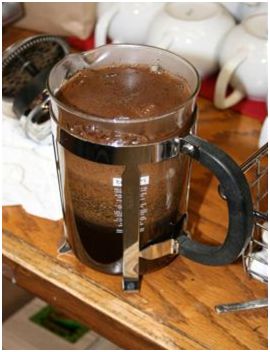Coffee is processed in several ways. Let’s start with the coffee cherry which is the fruit that is harvested from coffee trees.
When Red Rooster Coffee receives its coffee order the ‘meat’ of the cherry, the pulp, has been stripped off and we get a 60 kilo bag full of the seed that is inside the cherry – the small green bean.
That’s simple enough.
What is really interesting, and what has an amazing impact on the taste of your coffee, is what happens to the cherry between picking and becoming the bean that we roast and deliver to you. In other words, how it is processed.
Typically there are three ways to process the coffee. There is Dry Processing, Wet Processing, and something in-between called Semi-Wet Processing. And there is also a very interesting processing technique unique to the Malabar coast of India called ‘Monsooning’.
Dry Processing:
This type of processing, also called the Natural Method, is the oldest form of processing coffee. Very simply the coffee is picked and then dried in the sun. Usually the coffee cherries are laid out on a large concrete slab, a patio, or on raised tables. Then they are regularly turned over, a few times a day, so they can dry evenly. Drying the cherries can take a month or more.
Surely, at least once in our life, you’ve left a plum or a peach in your window sill until it is a completely dehydrated leathery . . . blob.
As the skin of the cherry, the exocarp, and the meat underneath the skin, the mesocarp, which includes the sticky, sugary substance around the bean called mucilage, dry in the sun you can imagine the chemical changes going on inside that blob. The sugars, the acids, the enzymes evaporating or concentrating and seeping into the seed—the coffee bean.
At night or when it rains the cherries are covered. And when the moisture content in the cherries reaches 11% it is coffee time. The blobs are removed from the patio, or the raised tables, and stored for processing.
Now the dry process coffee will have to be ‘hulled’—the dried cherry pulp is removed leaving only the bean. Since most coffee farmers are small operators, usually farming just a few acres, it isn’t economically feasible for them to own the equipment to do the hulling so they usually bring their coffee to the local coffee mill or to a cooperative they belong to that owns the equipment.
After hulling the coffee beans are sorted, graded, bagged and sold.
Even though this is a less expensive way of processing coffee than the wet method that doesn’t mean that the coffee produced is inferior. No, not at all. Many growers and drinkers alike think the dry processing method yields a more complex cup. So we wouldn’t say it is better or worse than coffee processed by the other methods, just different and something else to explore on your coffee tasting journey.
Wet Processing
This method is much more labour, machine, and resource intensive – which means the final product costs quite a bit more. That price though pays for a coffee that is usually regarded as producing a far superior, better tasting cup.
The wet process—also called Parchment Coffee, Washed Coffee, and Plantation Coffee—starts with more selective harvesting, choosing the best, ripest beans and leaving the others until they are properly ripe.
Next the cherries are sorted and cleaned in running water and then as soon as possible after picking they are ‘pulped’. Pulping is done by running the beans through a machine that removes the skin and meat of the cherry, leaving just the sugary mucilage, or parchment behind, still clinging to the bean.
Next the beans are run through a series of vibrating screens to further clean them and are washed again. Then they are moved to big concrete fermentation tanks for 24-36 hours. Here natural enzymes are used to attack the remaining pulp and mucilage surrounding the coffee bean, breaking it down so that most of it can be washed away. What is left surrounding the bean is called the ‘parchment’. The dried mucilage.
By the way, in countries such as Ethiopia, where water is a scarce commodity, you can see how this process adds to the cost of the coffee. Ecologically sensitive farms reprocess the wastewater along with the pulp and mucilage as compost to be used in soil fertilization programs.
Now the washed coffee is dried in the sun much like its ‘natural process’ cousin. This time though, since only the bean, instead of the whole cherry, is being dried, this process is reduced from 30 days or so to 8 – 10 days. On some high production plantations large drying machines are used to speed up the process.
All these processes are very carefully monitored as too much or too little at any stage along the way can detrimentally affect the coffee’s taste.
Finally the wet processed coffee is cured. The dry parchment is removed in a hulling process and then the coffee is sorted and graded. Most all of this work is done by hand.
Semi-Dry Processing
This is more or less a combination of the two previously described coffee processing methods whereby the cherries are initially wet processed but are not put in a fermentation tank to remove the mucilage (and any remaining pulp). Instead of the fermentation tank the coffee is now dried and processed according to the dry process method.
Monsooned Malabar Process
This processing method is unique to the others and requires a bit of a history lesson.
During the time of British rule in India coffee was harvested along the Malabar Coast in southwest India and shipped to Britain. During the long sea voyage, taking six months or so in a sailing ship, the coffee stored in the hold was subjected to the moist, salty, sea air and its taste was affected – evidently for the better. The green beans swelled to about double in size and their colour changed from green to a mellow yellow, golden color.
With the advent of steam ships, travel time was greatly reduced and the exposure time of the coffee beans to the sea air was lessened accordingly. The great flavour of the Malabar coffee that people had come to love was lost.
Since people still wanted the taste of long ocean voyage coffee which had more depth, richness, and character, it was discovered that the coffee could be ‘monsooned’. In this process the coffee is stored in special warehouses and during India’s monsoon, or rainy season which runs from June through September, the walls of the warehouses are opened up to let the moist air circulate among the beans. Since the monsoon is blowing in off of the ocean it is salty sea air.
The beans are transformed, reaching back in time to produce a coffee every bit as good as the coffee that had spent months in the hold of a sailing ship. The taste, flavour, and aroma of Indian Malabar coffee is recreated when it is properly monsooned.
As you can see, just as the taste of most every coffee is distinctly different, the various processing methods all have their own way of adding to or taking away from the taste of your coffee.



